07 - Phagocytosis and Endocytosis; Plasma Membrane Transport
1/50
There's no tags or description
Looks like no tags are added yet.
Name | Mastery | Learn | Test | Matching | Spaced |
|---|
No study sessions yet.
51 Terms
Which statement is TRUE?
A. Constitutive secretion involves secretory vesicles, whereas regulated
secretion does not.
B. It is not possible to have both regulated and constitutive secretion in the
same cell.
C. Only some cells perform regulated secretion while all cells perform
constitutive secretion.
D. Only some cells perform constitutive secretion while all cells perform
regulated secretion.
E. All cells perform both regulated and constitutive secretion.
c
Endocytosis
Process of bringing material from the plasma membrane (or extracellular environment) inside the cell.
Once material enters, there is bi-directional trafficking regulating the fate and final destination.
where does Endocytosis take place
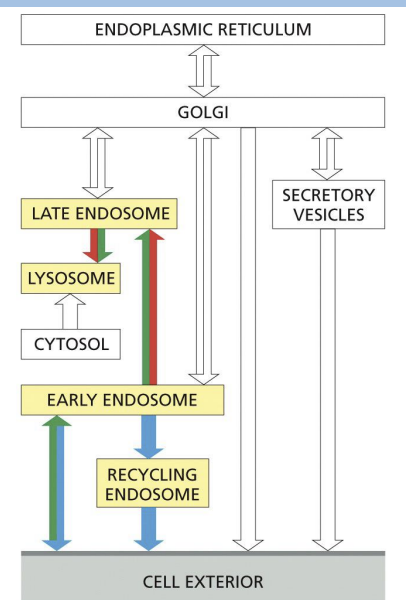
Early endosome
where internalized cargo is sorted.
Recycling endosome =
direct return to PM or storage of proteins for (indirect) PM.
Late endosomes =
mature endosomes that do not send vesicles to PM and can fuse with lysosomes/ endolysosomes.
Which one of the following statements about the control of membrane traffic is correct?
A. The outward flow exceeds the inward flow to maintain sizes of compartments.
B. The outward flow of membrane is less than the inward flow in growing cells.
C. Synaptic vesicles fuse faster than they can recycle, growing the nerve terminal.
D. The outward and inward membrane flows are balanced in a nongrowing cell.
d
Pinocytosis
Process of cell “drinking” = constant formation of endosomes from plasma membrane
Cell surface area and volume doesn’t change!
Mainly clathrin coated vesicles but also get caveolae (cause flask-like invaginations of membranes)
Macropinocytosis
clathrin independent route of endocytosis.
Triggered by signalling pathways that cause PM to ruffle.
Macropinosomes fuse with endosomes = degradation.
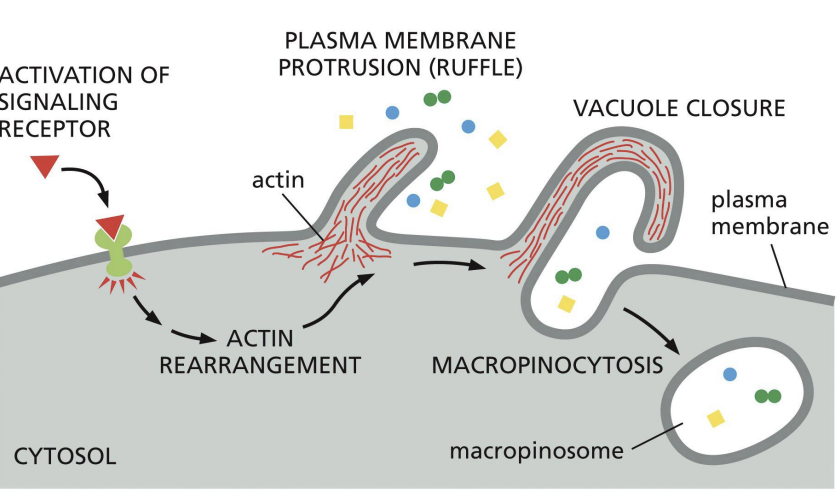
Receptor-mediated endocytosis
cell surface receptors bind specific cargo for internalization e.g. Cholesterol uptake (cholesterol is transported in low-density lipoprotein complexes (LDLs).
When cells require cholesterol, they increase the number of LDL-receptors on PM.
Receptor-mediated endocytosis of LDL allows cell to access cholesterol once the LDL particle is processed in lysosomes
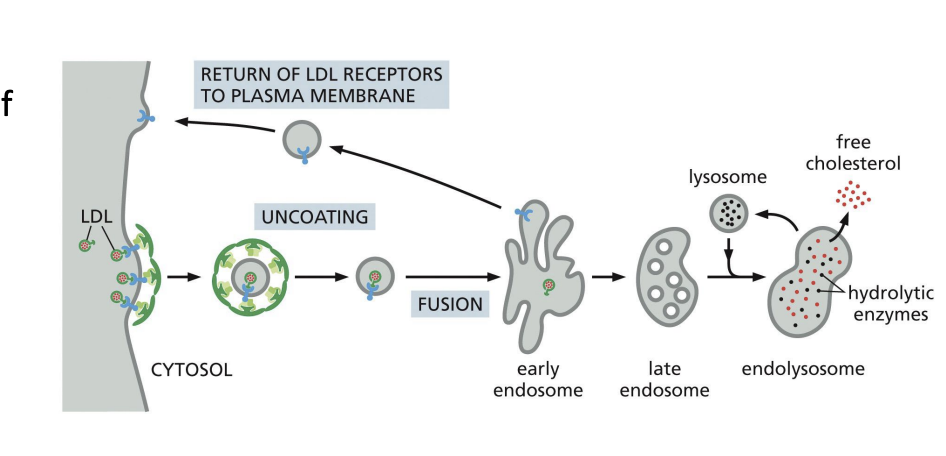
Receptor-Mediated Endocytosis Cargo receptor fates:
1) Recycled back to PM (e.g. Transferrin receptors)
2) Follow the fate of endocytosed material moving to lysosome for degradation (e.g. EGF receptor)
3) Transcytosis (recycled to different PM domain)
1) Recycled back to PM (e.g. Transferrin receptors)
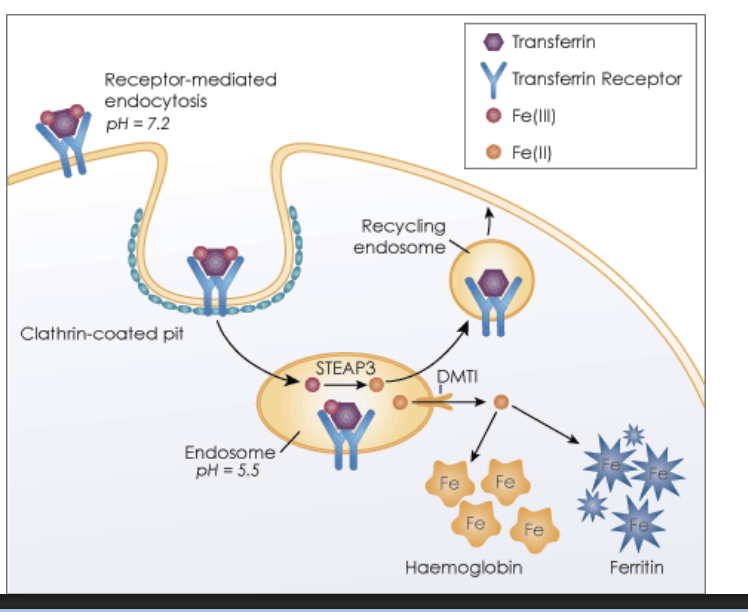
2) Follow the fate of endocytosed material moving to lysosome for degradation (e.g. EGF receptor)
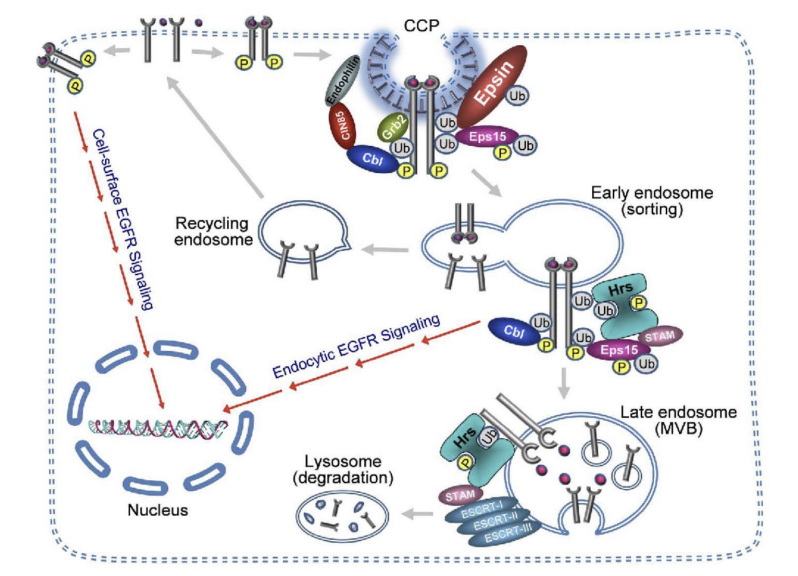
3) Transcytosis (recycled to different PM domain)
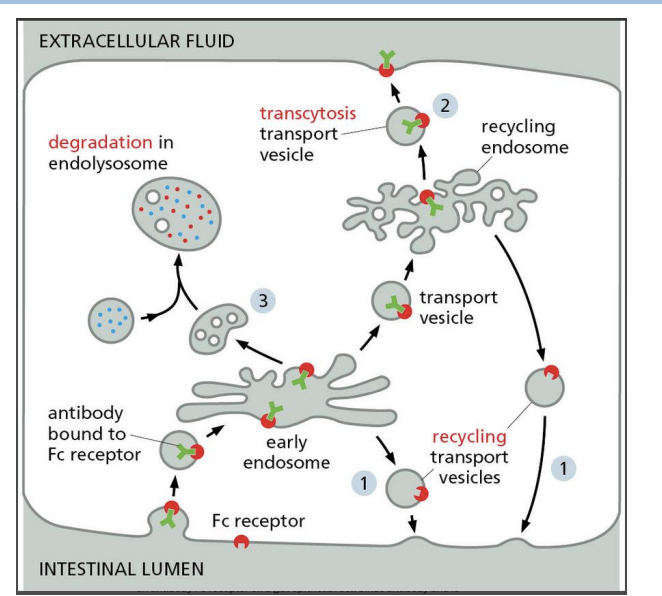
Recycling endosomes in Receptor-Mediated Endocytosis
Recycling endosomes can store proteins and move them to the PM when needed.
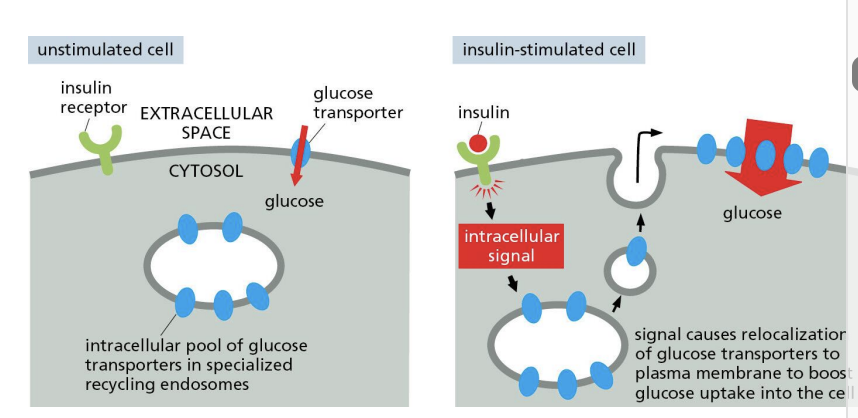
Phagocytosis
form of endocytosis performed by specialized cells (e.g. macrophages) = cell “eating”.
Receptor-mediated internalization that forms large endocytic vesicles (phagosomes).
Some bacteria are able to secrete proteins that prevent fusion of phagosome with lysosome
They live and multiple in these structures e.g. Mycobacterium tuberculosis
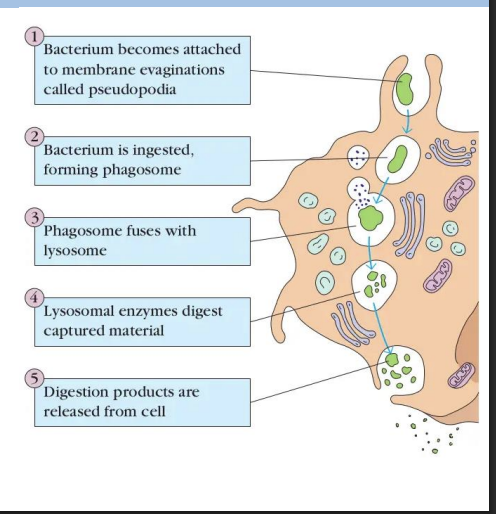
Autophagy
“self-eating” = process of cell engulfing obsolete components (e.g. proteins, organelles) in autophagosome to get rid of them.
Nonselective autophagy =
a bulk portion of cytoplasm is sequestered in autophagosomes.

Selective autophagy
autophagosomes tightly enclose specific cargo and mostly exclude the surrounding cytosol.
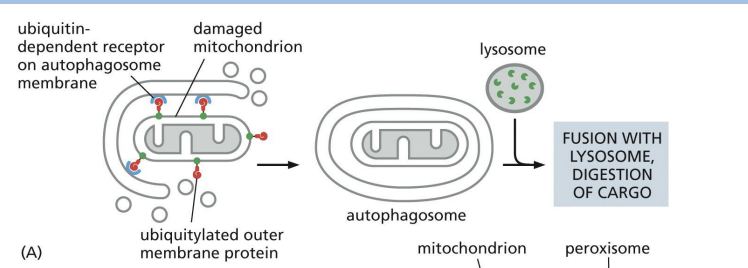
Which of the following is NOT a difference between phagocytosis and autophagy?
A. Only one of the two processes is a type of endocytosis.
B. Autophagosomes and phagosomes have distinct destinations in the cell.
C. Phagocytosis is specific to a few cell types, while autophagy is a common
cellular degradation mechanism.
D. Autophagy degrades intracellular material, while phagocytosis degrades
extracellular material.
b
Plasma membrane has dual function:
• Keep contents of cell in it
• Allow exchange of materials in and out of the cell
Diffusion
substance moves from regions of high to low concentration.
Factors that influence: Diffusion
1) Polarity (more lipid soluble = faster)
2) Size (small uncharged molecules = faster)
Membrane transport
move solutes across membranes.
Movement can be active or passive for transporters.
Membrane Transport types
1) Transporters
2) Channels
1) Transporters
• Bind solute specifically
• Change conformation so solute-binding sites are on one side followed by the other
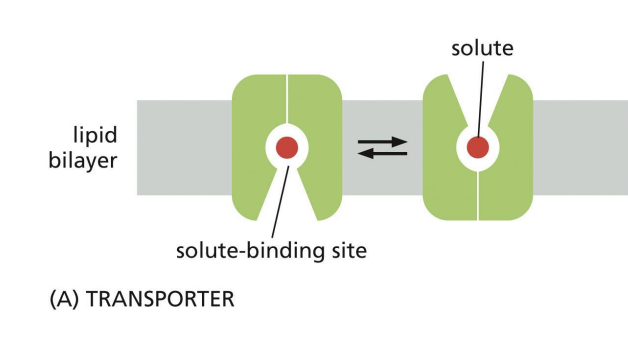
2) Channels
• Interact weakly with solute
• Form continuous pore
• Open = ions or small molecules can cross membrane
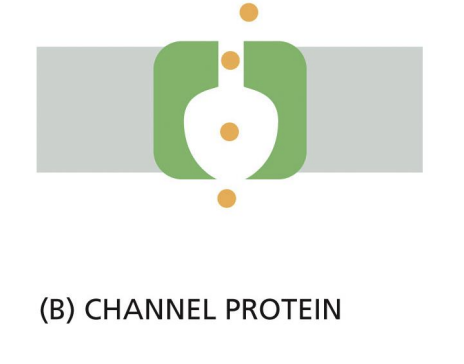
Simple Diffusion Through: Channels
Channels :
• Allow for bi-directional movement
• Selectivity to a type of ion (move down gradient)
• Gate = open or closed state
selectivity filter.
Ions will shed associated water molecules and line up in single file to get through narrowest part of channel
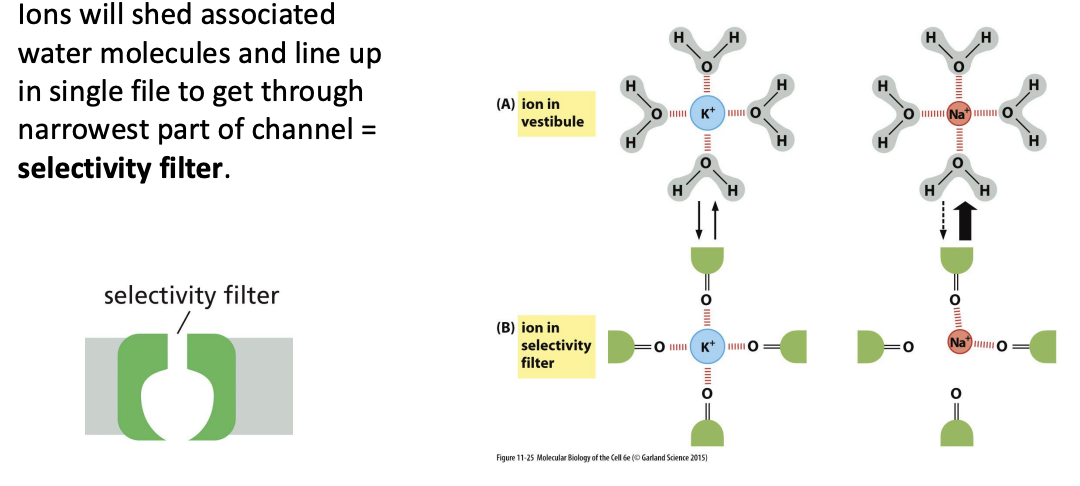
Types of Channel Diffusion
Voltage-gated
Ligand-gated
Mechanically-gated
in Simple Diffusion Through Channels, Opening depends on
Opening depends on difference in ionic charge between two sides of membrane. Altered membrane potential can trigger conformational changes in voltage-gated channels.
E.g. K+ ion channel:
• Multisubunit complex
• High selectivity for ions
Facilitated Diffusion Through Transporters
Binding of transporter on one side of PM = conformational change for bound molecules to gain access to other side.
Facilitated Diffusion Through Transporters: Transporters
• Operate passively (bi-directional)
• Relative concentrations determine direction of
net flux
• Specific for molecules they bind
• Mediate entry of polar solutes (e.g. sugars)
• Do not require energy
• Can be regulated
Glucose transporter helps
diffusion of glucose from bloodstream into cells.
Glucose binds one of several glucose transporters (e.g. GLUT1, GLUT2, etc)
diffusion of glucose from bloodstream into cells process
Blood sugar level and Insulin low → GLUT 4 in cytoplasmic vesicles (endocytosed) = few transporters on PM → very little internalization of glucose into cells.
Increase in blood sugar level raises insulin levels (secreted) → Insulin binds to insulin receptors on PM → send signal for vesicles to exocytose GLUT4 = more transporter on PM → more internalization of glucose into cells.
Diabetes Type II
Defects in insulin or GLUT4 receptors
Active transport
movement of ions against concentration gradient.
Transporters in Active transport
• Bind molecules specifically
• Binding causes conformational change that allows transport
• Require energy e.g. coupled transport or energy from ATP hydrolysis, light or
redox reactions
P-type pumps =
phosphorylate themselves during pumping cycle, transport ions
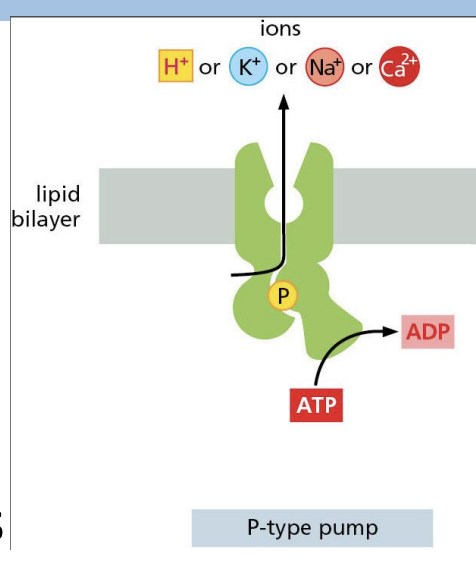
ABC Transporter =
ATP Binding Cassette, transport organic molecules
largest family of membrane transport proteins
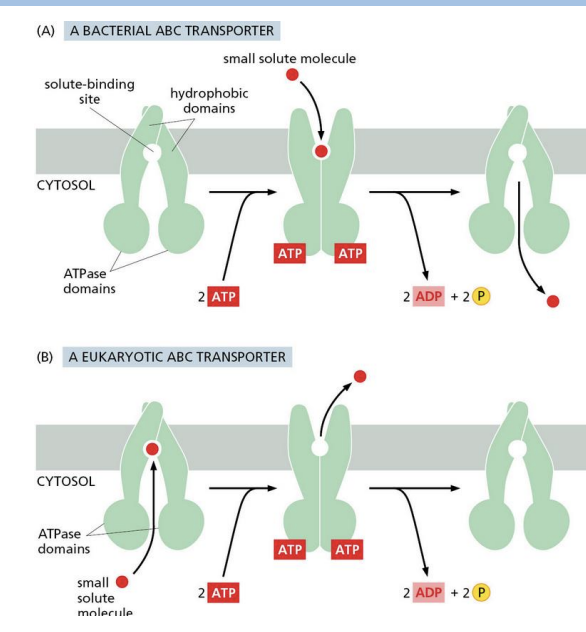
V-type pumps =
proton pumps used to acidify organelles
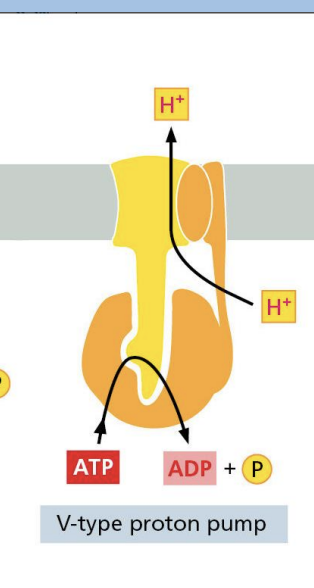
F-type pumps =
work in reverse of Vtype (synthesize ATP using H+ gradient)
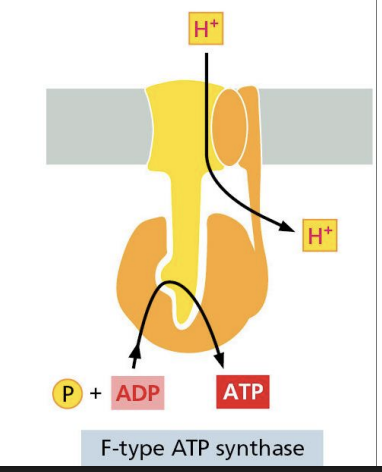
Sodium-Potassium (P-type) pump
Na+/K+ ATPase
Pumps Na+:K+ in ratio of 3:2 (pumps 3 sodium ions out for every 2 potassium ions in.
Responsible for excess Na+ outside the cell and excess K+ inside the cell.
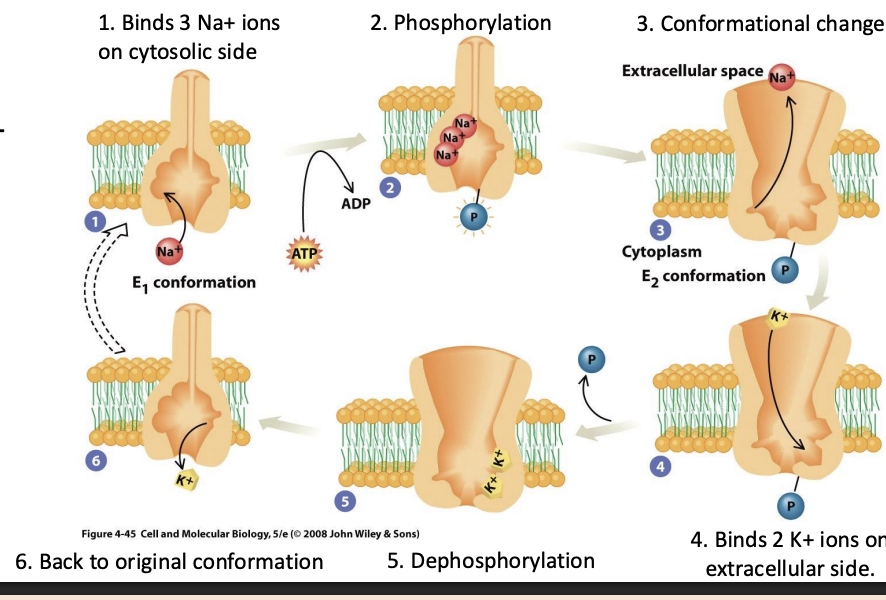
Which of the following statements about ATP-powered pumps is NOT true?
A) F-class and V-class pumps transport the same ion but in opposite directions.
B) ABC transporters are found in organisms ranging from bacteria to humans.
C) Only P-, F-, and V-class pumps transport ions.
D) All ATP-powered pumps contain at least one transmembrane domain.
c
Ligand-gated ion channels:
Neurotransmitter (glutamate = ligand) which can bind AMPA and NMDA receptors.
AMPA receptors =
glutamate gated channels.
NMDA receptors =
double gated (glutamate bound in strongly depolarized membrane)
Phosphoinositides (PIs) are minor phospholipids restricted to the cytosolic monolayer of cellular membranes. Given their larger head groups (compared to most major phospholipids), would you expect their accumulation at a domain of the plasma membrane to induce the membrane to bulge toward the monolayer containing the PIs (positive curvature) or in the other direction (negative curvature)? Would you expect this accumulation to assist or resist the formation of vesicles that bud into the cytosol (endocytic vesicles)?
A. Accumulation would cause negative curvature and assist endocytic vesicle formation.
B. Accumulation would cause positive curvature and resist endocytic vesicle formation.
C. Accumulation would cause negative curvature and resist endocytic vesicle formation.
D. Accumulation would cause positive curvature and assist endocytic vesicle formation.
d
Which of the following scenarios is consistent with a defect in the pathway for secretory vesicle transport?
A. The vesicles secrete their cargo when the cell receives a stimulatory signal, like a hormone binding to its receptor on the cell surface.
B. The vesicles fuse with the plasma membrane and release their cargo immediately upon reaching their destination.
C. The vesicles stay near, but not fused to, the plasma membrane when they first leave from the Golgi complex.
D. Two of the above are correct.
E. None of the above are correct.
e
If you only consider regulated transport, then B is a defect.
What would happen if you incubated cultured human fibroblasts in a medium containing LDL particles at 4 °C?
A. The LDL particles would bind to their receptor and be internalized into the cell. A coated vesicle would form; however, the vesicle would not move toward or fuse with an early endosome.
B. The LDL particles would not bind to their receptor because the temperature would be too low.
C. The LDL particles would bind to their receptor but would not be internalized into the cell.
D. The LDL particles would bind to their receptor and be internalized into the cell. A coated vesicle would form; the vesicle would move toward and attach to an early endosome. However, the coated vesicle would not fuse with the endosome or deliver its contents.
E. This entire process from ligand-receptor binding, coated-pit formation, pinching off a coated vesicle from the PM, and delivery to the early endosome would proceed but at a slower rate than normal
c
Which of the following statements about ATP-powered pumps is NOT true?
A) F-class and V-class pumps transport the same ion but in opposite directions.
B) ABC transporters are found in organisms ranging from bacteria to humans.
C) Only P-, F-, and V-class pumps transport ions.
D) All ATP-powered pumps contain at least one transmembrane domain.
c